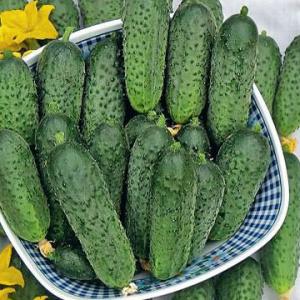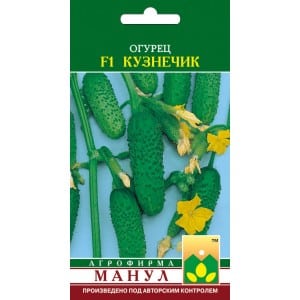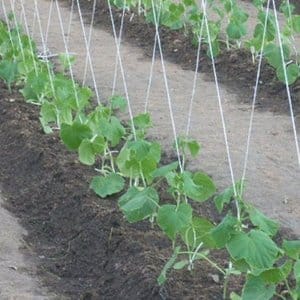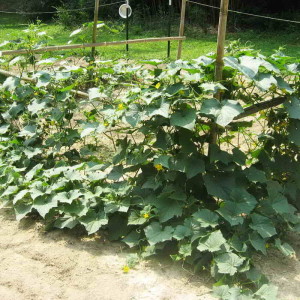Early hybrid of cucumbers “Grasshopper” from domestic breeders
There are cucumber beds in all summer cottages. When choosing seeds of this plant, experienced gardeners give preference to hybrids. One of the most popular and in demand crops is Grasshopper F1. The hybrid is characterized by early ripeness and productivity.
Description of the hybrid
Cucumber Grasshopper F1 belongs to the first generation hybrids. It is not pollinated by bees. Has early ripening, the first harvest is harvested 39 days after emergence. This variety of cucumber can be grown both in a greenhouse and in open ground. The bushes will bear fruit until the first frost.
Reference! The Grasshopper F1 cucumber was bred by domestic breeders of the Manul agricultural company. The hybrid was included in the state register of breeding achievements of the Russian Federation in 2004.
Distinctive features
Features that make this hybrid attractive include:
- yield up to 14 kg per sq. m;
- early ripeness;
- excellent presentation;
- taste qualities,
- lack of bitterness;
- resistance to a number of common diseases.
Composition, properties, benefits, calorie content
This vegetable is 95% water and contains vitamins and minerals that are beneficial to the body. Its use has a beneficial effect on the kidneys and excretory system, normalizes the functioning of the gastrointestinal tract.
At the same time, the product is dietary, contains a small amount of sugar, and has a calorie content of only 15 kcal per 100 g.
Main characteristics
This cucumber hybrid has a strong creeping stem, not exceeding 2 m in length, with limited branching and shortened internodes. The leaves are dark green, rough, divided into five segments.
Flowers appear in the axils of the leaves. This parthenocarpic hybrid has only female flowers with fruiting embryos. In place of one leaf sinus, 2-6 ovaries are formed. The process of pouring cucumbers into a bunch occurs sequentially, one after another.
The fruits are cylindrical in shape with ribs, covered with large tubercles and have a bright green color. The average weight is 90-110 g, length is about 12 cm, diameter is 3.5 cm. The yield of the hybrid is high - per square meter. m you can collect 10-14 kg of fruit.
How to grow your own
There are two ways to grow this hybrid: seed and seedling. To obtain early production in unprotected soil, it is recommended to pre-prepare the seedlings.
Optimal sowing date – 35 days before the next planting in the ground.
For planting, it is better to use individual containers with drainage holes. The prepared soil is disinfected by pouring boiling water over it and the container is filled. Sow 2-3 seeds per container to a depth of about 1 cm. After which the seedlings are watered and kept at a temperature not lower than +20°C.
When sprouts appear, the containers are placed closer to the light source. Watering is done as the soil dries.
Do not neglect hardening of plants. This important stage allows them to better adapt during subsequent transplantation. The procedure begins 15 days after germination, opening the window for half an hour.
After a week of such preparation, the seedlings begin to be taken outside, gradually increasing the time spent in the open air. If the first 3-4 leaves are present, the seedlings are transplanted into the ground. The optimal period is considered to be the end of May-beginning of June.
Attention! If this hybrid is grown in a greenhouse or greenhouse, the seeds are sown immediately in a prepared bed in parallel rows. Open ground conditions are also suitable for Grasshopper F1. When stable warm weather sets in and the soil is prepared in an open and sunny area, you can begin sowing.
Growing and care
The hybrid is unpretentious and does not require special growing conditions. Pay attention to timely watering, preferably in the evening and with warm water. Water should not get on the leaves, so the bushes are watered at the root.
At an early stage of the growing season, be sure to loosen the soil and remove weeds. To ensure proper growth, prevent lodging of fruits, and improve illumination of bushes, trellises are installed - special gratings that serve as support for plants.
Important! Cucumbers are not recommended to be planted next to potatoes and herbs. The best neighbors on the site are corn, peas, beans, pumpkin and squash.
Features and possible difficulties

Grasshopper F1 is grown in most regions of Russia. Both beginning gardeners and experienced summer residents will not have any difficulties with this hybrid.
In addition to standard cultivation in open beds and greenhouses, many farmers choose it for industrial cultivation.
Diseases and pests characteristic of the variety
Common diseases of cucumbers (olive spot, powdery mildew, cucumber mosaic virus) do not affect the Grasshopper F1 hybrid. It has average protection against peronosporosis (downy mildew). The cause of this disease can be insufficient lighting, waterlogging, bad weather, and more often it affects greenhouse plants.
If a lesion is detected, they are treated with fungicides, the damaged areas are removed and burned.
To control pests, spray with a soap solution (25 g of soda and 5 g of liquid soap are diluted in 5 liters of hot water). This is an environmentally friendly insecticide. The procedure is repeated a week later.
Harvesting and application

Ripe fruits are harvested every other day. The collection is carried out in an unripe state so that the seeds are in the stage of milky development. It is recommended to cut cucumbers and not tear them off from the stem.
Grasshopper F1 fruits are tasty fresh, in salads, and suitable for conservation And pickling.
Advantages and disadvantages of the variety
Many cucumber lovers choose the Grasshopper F1 hybrid. Its undeniable advantages: unpretentiousness, ability to self-pollinate, strong immunity, taste characteristics and productivity.
The disadvantages of this hybrid include increased sensitivity to moisture and unsuitability for collecting seeds for subsequent propagation.
Reviews
Summer residents are generally satisfied with the hybrid and leave positive reviews about it on the forums.
Alena, Kaluga: «For several years now I have been growing the Grasshopper cucumber at my dacha. This hybrid has proven itself perfectly! It is unpretentious and does not require pollination. And the germination of seeds is encouraging. But the most important thing about it is the crispy and aromatic cucumbers that don’t taste bitter!”
Zinaida, Tyumen: “I believed the description of the variety on the packaging several years ago and decided to try to grow it. And I have never regretted it once over the years.The grasshopper grows equally well both in a greenhouse and outside - it is not afraid of cool weather and does not get sick. Allows you to get an early and abundant harvest. Many ovaries are formed. The greens ripen quickly and consistently; they have to be collected frequently. The cucumbers are delicious, they can’t compare with those sold in the store.”
Olga, Samara: “I planted Grasshopper F1 cucumbers for the first time as an experiment. And I liked the result so much that now this is my favorite hybrid! It turned out to be very productive, enough for winter harvesting. There are no barren flowers, the cucumbers are excellent.”
Read also:
Early ripening and self-pollinating cucumber "Shchedrik".
How to pickle cucumbers in a bucket for the winter in a cold way.
Young hybrid of cucumbers "Herman" for greenhouses and open ground.
Conclusion
Owners of personal plots, summer cottages and even farms actively cultivate the cucumber hybrid Grasshopper, noting its precocity and impeccable presentation. This variety has achieved recognition among thousands of crunchy cucumber lovers for its positive qualities.